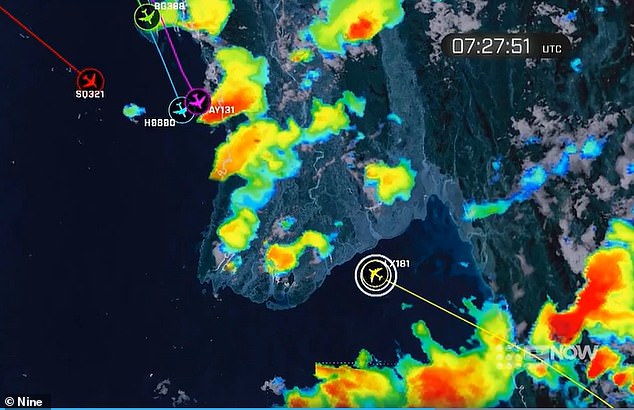Experts reject ‘clean air turbulence’ explanation for horror Singapore Airlines flight SQ321
A former Australian Air Force and Qantas pilot with more than three decades of experience flying passenger jets has shared his theory about what happened on board a deadly Singapore Airlines flight.
Retired pilot Richard Woodward suspects that Singapore Flight SQ321 from London to Singapore on May 21, 2024, ran directly into a thunderstorm.
Flight radar footage of the crash shows that other planes flying over Myanmar – where flight SQ321 hit catastrophic turbulence, killing one person and injuring more than 100 others – were able to avoid the storm’s activity.
However, SQ321 remained true to its intended route and flew straight into the heart of the storm.
Mr Woodward called the decision “a terrible miscalculation”.
He looked at the radar images and said 60 minutes on sunday: ‘They show [storm] cells are developing all over southern Myanmar, so there is a large area of thunderstorm activity.
‘Of course you would either go along the coast and swing around, or you would work your way through the cells, but you certainly wouldn’t try to fly into the wind direction of the thing, because that’s where the weather is blowing.’
Mr Woodward explained that passengers were “pushed into a huge downdraft by a huge updraft”, causing them to crash into the overhead bins.
Retired pilot Richard Woodward (pictured) on Sunday shared his theory that Singapore Flight SQ321 from London to Singapore on May 21, 2024, ran directly into a thunderstorm

Flight radar images (above) of the crash show that other aircraft flying over Myanmar avoided the storm activity. However, SQ321 (shown in red) stayed true to its intended path and headed straight for the core of the cell
“The plane effectively drops 175 feet, leaving anyone who isn’t strapped in on the roof of the plane and you’re pinned there as the plane falls,” he said.
‘But within a few seconds the pressure is back to positive G-forces and you’re slammed down onto whatever is underneath you – the seat backs, the floor, you name it, and bam – it’s all over in 4.6 seconds.
‘It is unheard of that so much damage occurs in such a short time.’
Mr Woodward said pilots misjudged the strength of the storm system and attempted to fly over it.
“I think they feel this is a harmless area and they can just fly over it and keep flying,” he said.
Many media outlets initially reported that there was “clear air turbulence,” a rare phenomenon in which aircraft are suddenly hit by severe turbulence without much visual warning.
However, Mr Woodward said clear air turbulence is “very rare” in tropical areas such as Myanmar, and pilots on SQ321 should have been able to see the storm’s lightning.

Kerry Jordan broke her spine when she was pushed from her seat into a cabin above her head (pictured Ms Jordan with her partner Keith Davis)
“The crew saw all these cells forming on the radar and had to consider whether or not to go around them. But because they’re not deviating, they think they can get through,” he said.
“…You shouldn’t be sitting in the front of a big plane unless you’ve been trained for years, but we don’t know what was going on in the cockpit and we don’t know what they were looking at.”
When pilots chose to fly through the storm cell, it was a choice that changed the life of Kerry Jordan, a passenger from South Australia.
Mrs. Jordan broke her spine when she was pushed out of her seat and into the cabin.
The horrific injury left Ms Jordan, a dance teacher, paralysed from the waist down and likely confined to a wheelchair for the rest of her life.
She has been in hospital since the devastating accident and cannot return to her old home due to access problems.
Ms Jordan and her partner, Keith Davis, were offered just $75,000 by Singapore Airlines.
When asked what he thought caused the crash, Mr Davis replied: ‘Someone wasn’t looking at the dial… what else can I think?
‘When you put yourself in a situation that could have been avoided by taking a detour… and then you hear that other flights flying in the same region at the same time are doing exactly that, it defies imagination.
“The data doesn’t lie.”

Mrs. Jordan (pictured), a dance teacher, was left paralyzed from the waist down and was likely confined to a wheelchair for the rest of her life.
A Singapore Airlines spokesperson said the airline “apologises to all passengers for the traumatic experience on board SQ321”.
“We are discussing the details of compensation directly with affected passengers or their designated representatives,” authorities said.
‘Singapore Airlines is committed to providing all necessary support and assistance to passengers on board SQ321.’
